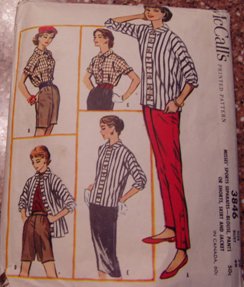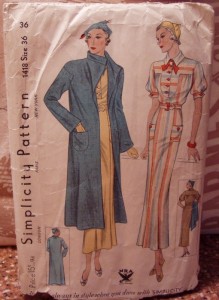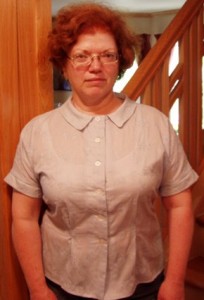 There are a lot of sewers out there who buy, collect and use vintage patterns (and no matter what the online retailers call them, I’m not sure you can consider Nolan Miller “Dynasty” sewing patterns from the 1980s to be exactly ‘vintage’ but that’s a discussion for another time). Everyone looks for something different. Some people are just looking for a particular style of dress from the 1950s or 1960s. Other people are more focused on sizing and pattern measurements (for the reason that people are just bigger and taller than they were 50-60 years ago, though for some people, it’s exactly the opposite problem). Other people have armed themselves with ‘how to redraft patterns’ skills so that they don’t care what size it is since they are going to redraft the pattern in their size in any case.
There are a lot of sewers out there who buy, collect and use vintage patterns (and no matter what the online retailers call them, I’m not sure you can consider Nolan Miller “Dynasty” sewing patterns from the 1980s to be exactly ‘vintage’ but that’s a discussion for another time). Everyone looks for something different. Some people are just looking for a particular style of dress from the 1950s or 1960s. Other people are more focused on sizing and pattern measurements (for the reason that people are just bigger and taller than they were 50-60 years ago, though for some people, it’s exactly the opposite problem). Other people have armed themselves with ‘how to redraft patterns’ skills so that they don’t care what size it is since they are going to redraft the pattern in their size in any case.
I buy and collect too. I have to admit that my madness is generally centered on the 50s. I’m a big believer that people get focused on certain styles worn by people they admire and were close to when they were young. My style icon is my mom from that period. She was young, very beautiful to my eyes and was an absolutely socko dresser. Even though I am built completely differently from her (she was 5’8″, very athletic, small bust, very long legs and I…am not), the clothing styles that always capture my eye are the ones from that period. Isaac Mizrahi, for example, has talked extensively about the effect on him of a) growing up in a household dominated by the dress-making business owned by his parents and b) growing up in a household surrounded by his mother and aunts during the 1950s and their wearing those styles of outfits. And his designs show this time and again. He was showing dresses with big swishy skirts, pencil skirts, darted waists in the bodices long before “Mad Men” came along. He used the same aesthetic in his design collections for Target, which were hugely successful.
But everyone is different. One of the things that does not draw my eye from this period is what people would consider the ‘classic’ shirtwaist dress. Part of that is because I actually wore that style of dress to elementary school, so it doesn’t hold any magic for me. So, what I look for in terms of seeking out patterns from that period are the outfits that show something different in terms of details, or an item which was popular but perhaps only for a time (such as the ‘sack’ dress with the back belt which actually eventually morphed into the sixties shift). Another aspect is whether I’ve seen this pattern before. Like other collecters and users of vintage patterns, I have favorite sites that I visit basically every day. There are patterns that you see basically all the time – they were obviously hugely popular and had big print runs. I had never seen this pattern ever before – once I saw what it was and the size that it was, I had to make it mine. I did not hesitate in terms of ordering it.
The pattern above was one which drew my eye immediately. First, it’s an ‘outfitter’ pattern, which always has an appeal in terms of thrift: The pattern comes with separate patterns for blouse, jacket, shorts, skirt and slacks. Today, a pattern trying to ape this appeal would probably have a jacket pattern with indications where you would cut the sleeve pattern for the blouse; a pants pattern with indications where you would shorten the pieces for the shorts and might or might not have a pattern for the skirt. Another special thing is that most items (the blouse, the jacket, the shorts and the slacks) all have the most amazing numbers of different facings to them, including facings for the bottom of where the hem would be on the shorts! Secondly, it features several design items which are unique: kimono sleeves on the jacket and blouse and that very unique button-up-the-side ankle treatment on the slacks. Very Gidget. Third, and this is a personal thing because even though I can draft, I would rather not, this pattern came in a size 20. For 1957, to find a pattern this stylish in a size 20 (measurements being 40-32-42) is a real find.
On the other hand, I do collect vintage patterns just to have them as a design resource – I don’t intend to ever actually make them. Here’s a good example – and not even from the 50s. This is from the 1930s and shows some of the very unique styling and detail work that is pretty common, even in home sewing patterns of the era. 
But let’s return to the 1957 outfitter. Did I actually use this pattern? Yes, I actually just finished the blouse, using blue on blue embroidered cotton that I got from here. The only change I had to make was that I took out one of the tucks in the front and one of the tucks in the back. That is the only difference. I love the way it fits – it’s a blouse that was easy to fit, easily fits me and that I plan to make in several other fabrics as well. The slacks come next.  (my stance is a little bit unbalanced here, which is why the neckline has shifted off; it really does fit correctly on my neck)
(my stance is a little bit unbalanced here, which is why the neckline has shifted off; it really does fit correctly on my neck)
So, what method do you use in terms of choosing vintage patterns?

I enjoy looking at vintage patterns as well . . . but the ones that truly catch my eye are ones that I actually made back in the late 60’s/early 70’s when I first learned to sew. They bring back memories of those so-called “happier times” when I was so young and carefree (hahaha, yeah, my early teen years . . . who am I kidding?). I have used some patterns from the 50’s and 60’s, but I’ve run into problems with things like dart placement (busts were perkier back then).
I do like that McCalls pattern . . . especially the striped shirt and slim pants/skirt!
Auntie Allyn – I always find it amazing when I find patterns that I made – or that my mom made for me when I was young. On the other hand, I’ve been looking for a John Kloss dress pattern from 1975 that I have never seen. So it was probably not terribly popular, I guess.